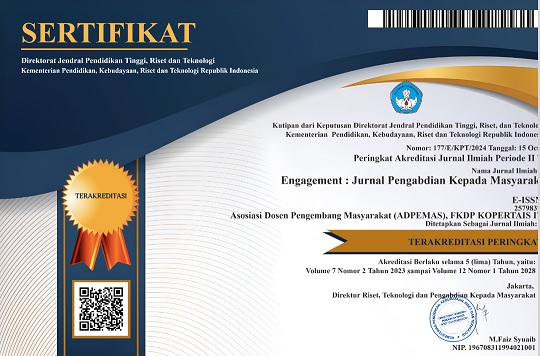Innovation of Walker for People with Disabilities using Bamboo Waste and Kenaf Fibers Reinforced Composites
Abstract
Bamboo has many benefits from roots to stems and is very easy to obtain in Indonesia. Bamboo is widely used for handicraft products, woven materials, textiles, buildings, and bridges. In addition, bamboo fiber has also been processed into various products to increase its potential and economic value, namely for applications in the field of engineering, including automotive, aircraft, and solar panels. However, the availability of bamboo fiber in Indonesia is not easy to obtain, and bamboo waste from handicraft products is generally only used for fuel. The bamboo waste is combined with natural kenaf fiber and processed into a composite material with an epoxy resin binder through this community service activity. The composite product is then used to innovate the walking aids (walkers) for people with disabilities, namely by adding eating and drinking mats to the walker. The composite material has also been tested for its impact toughness before use. This innovative product is expected to increase user benefits in rural communities.
Downloads
References
Abdullah, A. H. D., N. Karlina, W. Rahmatiya, S. Mudaim, and A. R. Fajrin. "Physical and mechanical properties of five Indonesian bamboos." In IOP Conference Series: Earth and Environmental Science, vol. 60, no. 1, p. 012014. IOP Publishing, 2017, DOI: 10.1088/1755-1315/60/1/012014.
Astuti, Erna Wiji, Fifit Astuti, and Sri Lastuti. "Serbuk Bambu sebagai Alternatif Bahan Dasar Tinta Braille." Pelita 3, no. 2 (2008): 113-124.
Ihsan, Muhammad, Almira Fikrani, Andar Bagus Sriwarno. Pemanfaatan Limbah Produksi Kerajinan Bambu Melalui Desain Produk Berbahan Dasar Arang. "Jurnal Sosioteknologi 18, no. 1 (2019): 43-55. doi: 10.5614/sostek.itbj.2019.18.1.4.
Ku, Harry, Hao Wang, N. Pattarachaiyakoop, and Mohan Trada. "A review on the tensile properties of natural fiber-reinforced polymer composites." Composites Part B: Engineering 42, no. 4 (2011): 856-873. DOI: 10.1016/j.compositesb.2011.01.010.
Mainaki, Revi, and Rendra Zainal Maliki. "Pemanfaatan Keanekaragaman Bambu Secara Hidrologis, Ekonomis, Sosial dan Pertahanan." Geodika: Jurnal Kajian Ilmu dan Pendidikan Geografi 4, no. 1 (2020): 44-54. doi: 10.29408/geodika.v4i1.1951.
Mutia, Theresia, Susi Sugesty, Henggar Hardiani, Teddy Kardiansyah, and Hendro Risdianto. "Potensi Serat Dan Pulp Bambu Untuk Komposit Peredam Suara." Jurnal Selulosa 4, no. 1 (2014): 25-36. DOI: 10.25269/jsel.v4i01.54.
Namvar, Farideh, Mohamad Jawaid, Paridah Md Tanir, Rosfarizan Mohamad, Susan Azizi, Alireza Khodavandi, Heshu Sulaiman Rahman, and Majid Dehghan Nayeri. "Potential use of plant fibers and their composites for biomedical applications." BioResources 9, no. 3 (2014): 5688-5706. [Online]. Available: bioresources.com.
Omar, Mohd F., Haliza Jaya, and Nik N. Zulkepli. "Kenaf fiber-reinforced composite in the automotive industry." Elsevier Ltd., 2020 9 no. c.(2020): 95-101.
Rina Lusiani, Sunardi, and Nico Pratama, “Studi Experimental Pengaruh Ukuran Partikel Serbuk Bambu terhadap Sifat Mekanis Komposit untuk Aplikasi Kampas Rem Sepeda Motor.” Fly Wheel 4, no. 2 (2016): 54-63.
Srinivas, K., A. Lakshumu Naidu, and MVA Raju Bahubalendruni. "A review on chemical and mechanical properties of natural fiber-reinforced polymer composites." International Journal of Performability Engineering 13, no. 2 (2017): 189. DOI: 10.23940/ijpe.17.02.p8.189200.
Sukawi. “Bambu Sebagai Alternatif Bahan Bangunan Dan Konstruksi di Daerah Rawan Gempa.” Jurnal Teras 10, no. 1 (2010). [Online]. Available: http://eprints.undip.ac.id/32377/.
Copyright (c) 2022 Engagement: Jurnal Pengabdian Kepada Masyarakat

This work is licensed under a Creative Commons Attribution-ShareAlike 4.0 International License.






.png)




